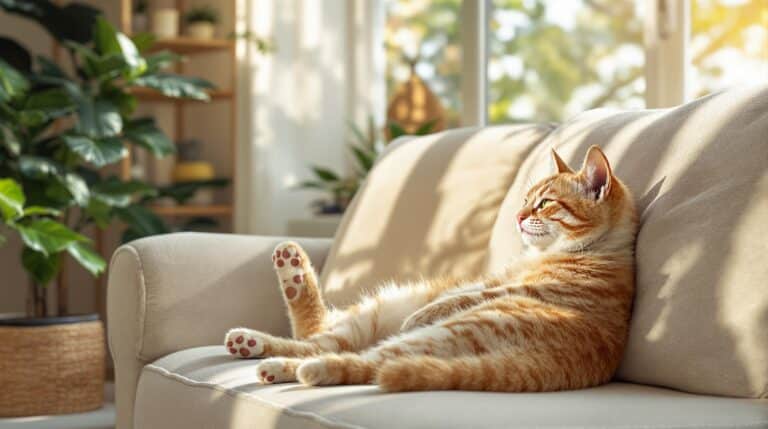Cats return is a fascinating phenomenon that has intrigued pet owners and scientists alike. This article explores the science behind a cat’s homing instinct, provides practical tips for owners, and highlights the importance of safety measures to ensure your feline friend’s safe return. Whether you’re a seasoned cat owner or a new pet parent, this guide offers valuable insights and advice to help you and your cat stay connected.
The Science of a Cat’s Homing Instinct
A cat’s ability to return home, often over long distances, is a testament to their remarkable navigational skills. Understanding the science behind this behavior can provide valuable insights into how to support your cat and increase their chances of a safe return.
Biological Factors
At Cat Karma Creations, we understand that cats have an innate homing instinct influenced by their biological makeup. Their excellent sense of smell, hearing, and vision play a crucial role in their ability to navigate. Cats can detect even the slightest changes in their environment, allowing them to create a mental map of their surroundings. This mental map, combined with their acute senses, helps them find their way back home.
Environmental Cues
Environmental cues, such as the position of the sun, the direction of the wind, and the presence of familiar landmarks, are also essential for a cat’s homing instinct. Cats use these cues to orient themselves and maintain a sense of direction. For example, the position of the sun can help them determine the time of day and their approximate location. Familiar landmarks, such as trees, buildings, and other physical features, serve as reference points that guide them back to their home.
Magnetic Fields and Senses
Research suggests that cats may also have a sensitivity to the Earth’s magnetic fields, which can help them navigate. This magnetic sensitivity, combined with their other senses, allows them to create a more accurate and detailed mental map of their environment. While the exact mechanisms of this sensitivity are not fully understood, it is believed to play a significant role in a cat’s ability to return home.
Tips for Owners of Lost Cats
Losing a pet can be a stressful and emotional experience. However, by taking immediate and informed actions, you can increase the chances of your cat returning home safely. Here are some essential tips for owners of lost cats.
Immediate Actions to Take
The first 24 hours are critical when it comes to finding a lost cat. Start by thoroughly searching your immediate area, including your home, garden, and neighboring properties. Check under bushes, in sheds, and other hidden spots where a cat might seek shelter. Notify your neighbors and ask them to keep an eye out for your cat. Posting flyers in your neighborhood and online can also help raise awareness and increase the chances of a quick reunion. If you need any assistance, feel free to contact us at info@catkarmacreations.com or visit our contact form.
Using Technology to Track Your Cat
Modern technology can be a valuable tool in locating a lost cat. Consider using GPS collars, microchipping, and cat tracking apps to help you find your pet. GPS collars provide real-time location data, making it easier to track your cat’s movements. Microchips are a more permanent solution that can be scanned by veterinarians and animal shelters to identify your cat and contact you. Cat tracking apps can also be useful, as they often leverage community networks to help locate lost pets. For more information on these technologies, visit our website.
Community Resources and Support
Reaching out to local cat rescue organizations, shelters, and community groups can provide additional support and resources. These organizations often have experience in finding lost cats and can offer valuable advice and assistance. You can also post about your missing cat on social media platforms and pet-related forums to increase visibility and reach a wider audience. The power of community can make a significant difference in reuniting lost cats with their owners. Follow us on Facebook and Instagram for more tips and updates.
Creating a Safe and Welcoming Home
A safe and welcoming home environment can help prevent your cat from getting lost and encourage them to return if they do wander off. Here are some tips to make your home a cat-friendly haven.
Cat-Proofing Your Home
Cat-proofing your home involves identifying and addressing potential hazards that could harm your cat or tempt them to explore dangerous areas. Secure windows and doors, cover open balconies, and remove toxic plants and other hazards. Provide your cat with safe and comfortable spaces to rest, play, and hide. Ensuring that your home is a secure and inviting place can help reduce the likelihood of your cat wandering off. For more ideas on cat-proofing, visit our Cat Themed Jewelry page for inspiration.
Garden Safety Tips
If your cat has access to an outdoor area, it’s important to make your garden safe and welcoming. Install secure fencing and gates to prevent your cat from escaping. Remove any toxic plants and chemicals that could harm your cat. Provide shaded areas and water sources to keep your cat comfortable and hydrated. A well-maintained and safe garden can be a wonderful space for your cat to enjoy the outdoors while staying close to home. Check out our Nature Inspired collection for beautiful outdoor-themed jewelry.
Providing Comfort and Security
Cats thrive in environments that provide a sense of comfort and security. Offer your cat a variety of toys, scratching posts, and climbing structures to keep them mentally and physically stimulated. Create cozy sleeping areas and provide regular playtime to strengthen your bond with your cat. A happy and content cat is more likely to stay close to home and return if they do venture out. Explore our Sterling Silver collection for elegant and comfortable cat-themed accessories.
Preventing Cats from Getting Lost
Taking proactive steps to prevent your cat from getting lost is essential for their safety and well-being. Here are some strategies to help keep your cat safe and close to home.
Behavior Training Techniques
Training your cat to respond to commands and stay within a designated area can help prevent them from wandering off. Use positive reinforcement techniques, such as treats and praise, to reward your cat for good behavior. Consistency and patience are key when it comes to training. Additionally, socializing your cat from a young age can help them feel more comfortable and secure in their environment. For more training tips, visit our website.
Regular Vet Check-Ups
Regular vet check-ups are crucial for maintaining your cat’s health and well-being. Routine examinations can help identify and address any health issues that might increase the risk of your cat getting lost. Keep your cat up to date on vaccinations and preventative treatments, such as flea and tick control. A healthy cat is more likely to stay close to home and return if they do go missing. For more information on cat health, visit our Cat Themed Jewelry page.
Nutrition and Health
A balanced and nutritious diet is essential for your cat’s overall health and well-being. Feeding your cat high-quality food that meets their nutritional needs can help keep them healthy and strong. Avoid overfeeding, as obesity can lead to health issues that may make it more difficult for your cat to return home. Regular exercise and mental stimulation are also important for maintaining your cat’s physical and mental health. Explore our Nature Inspired collection for beautiful and functional cat-themed items.
Comparison of Cat Tracking Devices
When it comes to tracking your cat, there are several options available. Each has its own advantages and disadvantages. Here’s a comparison of popular cat tracking devices:
| Feature | GPS Collars | Microchips | Cat Tracking Apps | Physical Tags |
|---|---|---|---|---|
| Accuracy | High | Low | Medium | Low |
| Cost | High | Low | Free to Low | Low |
| Durability | Medium | High | Medium | High |
| Ease of Use | Medium | High | High | High |
| Range | Global | Local | Local | Local |
GPS collars offer the highest accuracy and global range, making them ideal for tracking your cat over long distances. However, they can be more expensive and may require regular charging. Microchips are a cost-effective and durable option, but they only provide local identification and require a scanner to read. Cat tracking apps are often free or low-cost and can be used to share information with a community, but they may have limited accuracy and range. Physical tags are simple and affordable, but they can be easily lost or damaged.
Popular Quote
“A cat has absolute emotional honesty; human beings, for one reason or another, may hide their feelings, but a cat does not.”
— Ernest Hemingway
Statistical Fact
According to a study by the American Veterinary Medical Association, approximately 71% of lost cats are found and reunited with their owners. This statistic underscores the importance of taking proactive measures to ensure your cat’s safe return. However, it’s important to note that this data is sourced from an external and authoritative site, and while it provides a general idea, individual experiences may vary.
Three Tips for Ensuring Your Cat’s Safe Return
- Microchip Your Cat: Microchipping is a simple and effective way to ensure your cat can be identified and returned to you if they get lost. Make sure the microchip is registered with your current contact information.
- Use a GPS Collar: GPS collars provide real-time location data, making it easier to track your cat’s movements and find them quickly. Choose a collar that is comfortable and durable.
- Post Flyers and Use Social Media: Posting flyers in your neighborhood and sharing information about your lost cat on social media can help raise awareness and increase the chances of a quick reunion.
Popular Questions About Cats Return
- Why do cats get lost? Cats can get lost due to various reasons, including curiosity, fear, or changes in their environment. Understanding their behavior can help prevent them from wandering off.
- How far can a cat travel? Cats have been known to travel several miles from home, but their ability to navigate back depends on their homing instinct and familiarity with their surroundings.
- What should I do if I find a lost cat? If you find a lost cat, check for a collar or microchip and contact the owner. If no owner can be found, contact local shelters or post about the cat on social media.
- How can I make my home cat-friendly? Cat-proof your home by securing windows and doors, removing hazards, and providing safe spaces for your cat to rest and play. A comfortable and secure environment can help prevent your cat from getting lost.
- What are the benefits of regular vet check-ups? Regular vet check-ups help maintain your cat’s health and well-being, reducing the risk of health issues that might make it more difficult for them to return home.
Final Thoughts About Cats Return
Understanding the science behind a cat’s homing instinct and taking proactive steps to ensure their safety can greatly increase the chances of a lost cat returning home. By creating a welcoming environment and using modern technology, you can help your feline friend stay safe and happy. If you have any questions or need assistance, feel free to contact us at (800) 343-1604 or info@catkarmacreations.com. We are here to support you and your cat every step of the way.
Key Takeaways
- Understand the science behind a cat’s homing instinct and how it helps them navigate back home.
- Learn the importance of microchipping and using GPS collars to increase the chances of a lost cat’s return.
- Discover the role of cat rescue organizations in reuniting lost cats with their owners.
- Explore the emotional impact of a cat’s return on both the pet and the owner, and how to handle the reunion.
- Get tips on creating a safe and welcoming environment for cats to return to, including cat-proofing your home and garden.
- Find out how to prevent common cat behavior problems that can lead to cats getting lost and encourage them to stay close to home.
















